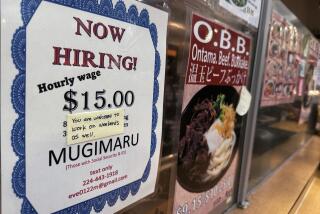Unemployment rate falls to 8.5%, lowest in nearly 3 years
REPORTING FROM WASHINGTON -- The nation’s unemployment rate dropped further in December, to the lowest level in nearly three years, as employers added a healthy batch of new jobs to close out a tumultuous year on an hopeful note for the millions of jobless American workers still struggling to get back on their feet.
The Labor Department said Friday that the jobless rate edged down to 8.5% in December from a revised 8.7% in November. The unemployment rate has fallen steadily since August, when the rate was 9.1%, based on revisions typically made at the end of the year.
Analysts say the big drop in joblessness in recent months overstates the actual improvement in the labor market. By the government’s definition, people are unemployed if they’re jobless and looking for work. Although layoffs at companies have receded, hiring has remained generally tepid and many people have dropped out of the labor force altogether; thus, they aren’t counted as among the unemployed.
Still, the December jobs report was a pleasant surprise to most analysts and good news for the White House. The economy added 200,000 new net jobs -- the most since last April and double the number added in November. Hours of work in the private sector ticked higher last month, and average hourly earnings also went up slightly.
“This is a really solid report, a huge step in the right direction,” said Heidi Shierholz, a labor economist at the Economic Policy Institute in Washington.
The latest jobs report adds to the body of evidence that the economy perked up in the fourth quarter, thanks to strong manufacturing and business investments, as well as resilient consumer spending.
There were some caveats in last month’s job-growth numbers, however. Although the data are seasonally adjusted, there was an unusual burst of hiring in transportation -- 42,000 new messengers and couriers were brought on in December -- and retailers added a larger-than-expected 28,000 positions after fattening their payrolls by 39,000 in November. It’s unclear how many of those positions will last.
The warmer-than-usual December weather also might have given a boost to payrolls. The hard-hit construction industry was up 17,000 jobs, for example.
Manufacturing, which has been a bright spot throughout the sluggish recovery, added 23,000 jobs behind the strength of producers of motor vehicles, metals and machinery. The healthcare industry added 29,000 jobs, a third of them at hospitals.
And eating and drinking places boosted staffing by 24,000 at year-end, something Mesirow Financial’s chief economist, Diane Swonk, attributed to “cash-rich companies [that] ramped up their holiday parties and entertaining after a hiatus in the wake of the financial crisis.”
But hiring at financial and professional services was dormant. The temporary-help industry cut 7,500 jobs in December. Government shed 12,000 from its payrolls -- all of that at public schools and other local agencies.
These and other drags in the economy raise doubts about whether the recent momentum can be sustained. Many analysts see only modest job and economic growth this year, concerned about consumers’ still-high debts and ability to spend vigorously, the weak housing market and external headwinds such as a recession in Europe that would hurt American exports.
In 2011, job growth accelerated early in the year but fizzled in spring as harsh domestic politics and shocks overseas -- the Arab spring, Europe’s debt woes and Japan’s double whammy of earthquake and tsunami -- pummeled stock markets and took the wind out of the economic sails.
For all of last year, the economy created about 1.6 million net new jobs, up from 940,000 added to payrolls in 2010.
Still, total U.S. payrolls are down about 6.1 million from December 2007 at the start of the Great Recession. And last month, a full 2 1/2 years after the recovery technically began, more than 13 million people remained jobless, and an additional 8.1 million part-time workers said they could not get full-time hours.
Even if the economy created 200,000 jobs every month from now on, Shierholz estimated that it wouldn’t be until 2019 that the economy got back to its pre-recession unemployment rate of 5%, given the workforce population increases.
“This report does not allow us to breathe any sigh of relief for 2012,” she said.
More to Read
Inside the business of entertainment
The Wide Shot brings you news, analysis and insights on everything from streaming wars to production — and what it all means for the future.
You may occasionally receive promotional content from the Los Angeles Times.










